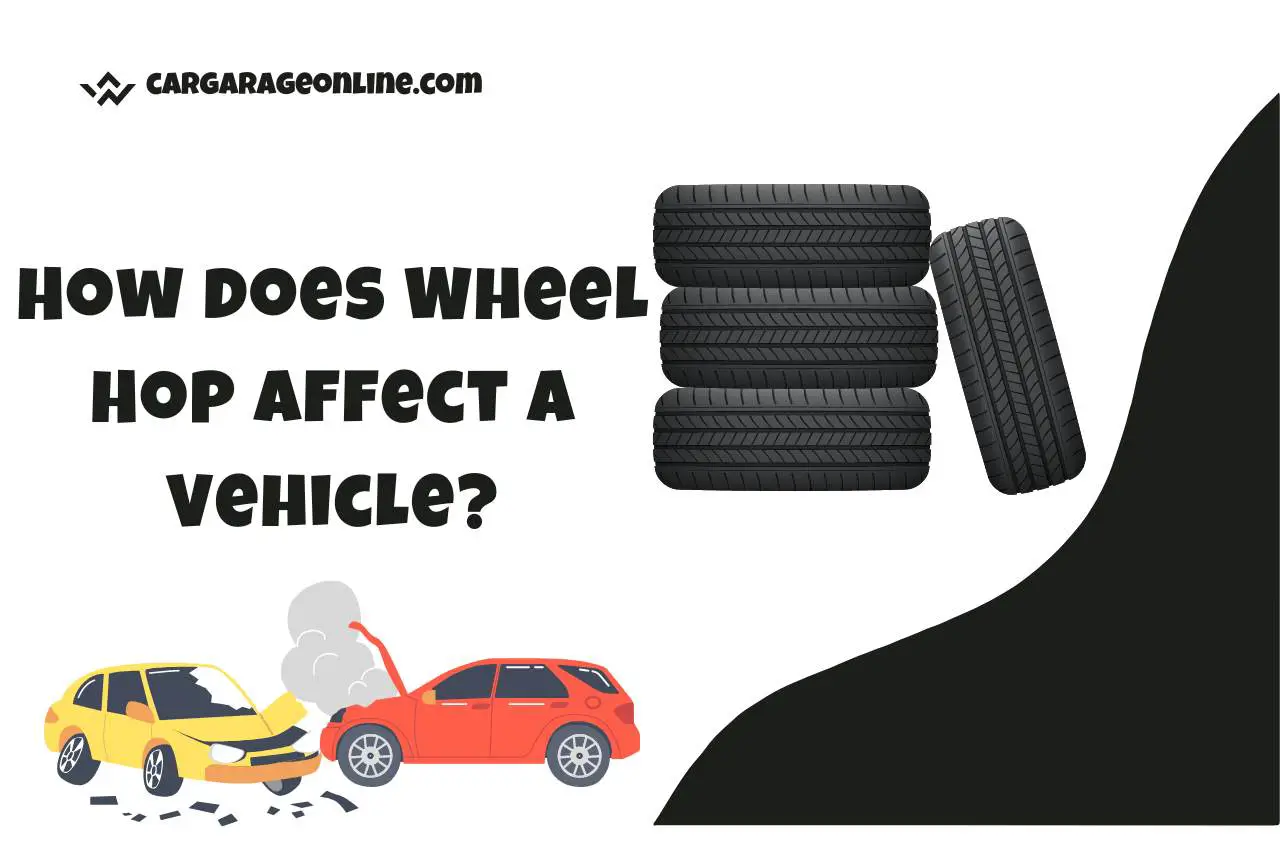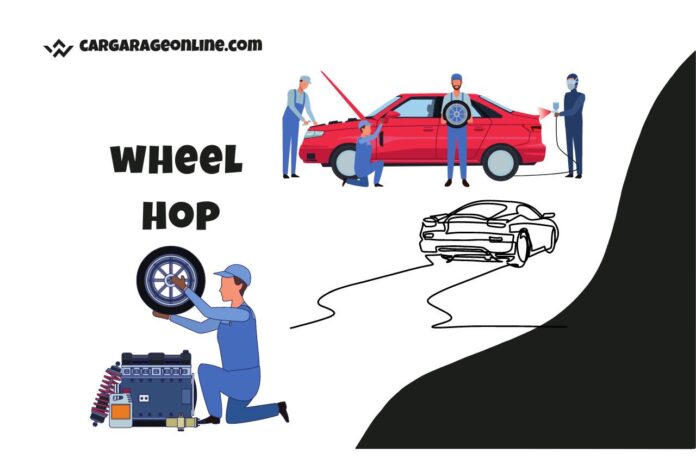Wheel hop is a phenomenon that happens in cars, especially during forceful braking or high-powered acceleration, where the tires briefly lose traction and then quickly regain it in a bouncing motion. The interaction of the tires, suspension, and road surface results in this constant bouncing. Wheel hop often results in a loss of traction, decreased performance, and the risk of damage to the vehicle’s components. It can be visibly witnessed when the tires rapidly skip or jump on the surface.
In this article, we will look at wheel hop’s causes and consequences, potential risks it may present, and ways to stop or lessen it from happening. Wheel hop may significantly impact how a car handles and how enjoyable driving is. Therefore, drivers and car enthusiasts need to understand it.
What is Wheel Hop?
Wheel hop occurs during acceleration or forceful braking when the tires rapidly lose and regain traction. The effect is that the tires hop or bounce on the road—the interaction of the tires, suspension system, and road results in this bouncing motion.
Due to the engine’s power and the suspension’s reaction to the torque load, the tires may briefly lose contact with the pavement when the wheels receive a substantial amount of torque during acceleration.
The sudden weight and force transfer might cause the tires to lose traction again just as they start to acquire it, resulting in a cycle of bouncing.
This cycle continues until the driver releases the gas pedal or stabilizes traction. Similar to when hard braking, using too much force can cause the tires to suddenly lose traction, which causes the wheels to bounce as they attempt to regain traction.
In high-performance or substantial automobiles, particularly those with rear-wheel drive and solid rear axles, wheel hop can be a frequent problem. It may result in decreased traction, a lack of control, and possible harm to the suspension, tires, and drivetrain parts.
Vehicle manufacturers and enthusiasts use a variety of strategies, including advanced suspension systems, traction control systems, and differentials, as well as bettering tire quality and maximizing weight distribution, to prevent or eliminate wheel hop. These actions improve traction and stability, making driving safer and more pleasurable.
Wheel Spin vs Wheel Hop
Wheel Spin
During acceleration, the tires lose grip and spin freely on the pavement. This often occurs when the wheels get excessive power, causing them to lose contact with the ground. Wheel spin can be caused by excessive engine torque, slick road conditions (such as wet or snowy surfaces), or poor tire grip. Wheel spin is when the tires turn quickly without getting a grip, which slows down acceleration and causes a loss of forward momentum.
Wheel Hop
This phenomenon happens during acceleration or forceful braking when the tires briefly lose traction and quickly regain it. On the road surface, the tires subsequently jump or bounce. Wheel hop typically happens due to several variables, including excessive torque or power being transferred to the wheels, how the suspension system reacts, and the state of the road.
To sum it up:
- Loss of grip during acceleration results in wheel spin, which causes the tires to spin freely without regaining traction on the road.
- Wheel hop is the constant tire hopping that occurs when there is a brief loss of traction and a subsequent gain during acceleration or forceful braking.
Wheel spin and wheel hop both affect a car’s performance and handling, as well as have a negative influence on the drivetrain and tire life. To alleviate or prevent these problems and enhance overall vehicle stability and control, manufacturers and enthusiasts employ various strategies, including traction control systems, limited-slip differentials, and improved suspension settings.

How does Wheel Hop Affect a Vehicle?
- Rapid traction variations between the tires and the road surface are known as wheel hop. In particular, during powerful launches, this causes a loss of traction and lowers the vehicle’s capacity to accelerate effectively.
- The car may become unstable due to the tires’ bouncing, making it challenging for the driver to maintain control. This instability can be dangerous when making fast maneuvers or doing sharp turns.
- Wheel hop puts excessive strain on the drive shaft, axle shafts, differential, and transmission. These parts may be subjected to quick and severe stresses due to the fast changes in traction, which could cause early wear, damage, or even failure.
- The suspension system is put under additional stress by the constant bouncing. Damage to parts, including shocks, struts, control arms, and bushings, may impair handling and raise maintenance costs.
- Wheel hop can cause uneven tire wear because it causes the tires to experience frequent traction and grip loss. Uneven wear can reduce tire life and make replacements more necessary.
- Wheel hop’s loss of stability and control can make collisions or loss of control more likely, especially under poor driving conditions or emergency scenarios.
- Wheel hop lowers the car’s overall performance by impairing its ability to accelerate, turn, and brake.
Signs of Wheel Hop
- During rapid acceleration or abrupt braking, you could experience a bouncing or hopping sensation from the vehicle’s rear. The rear end may be hopping up and down during the bouncing motion.
- During strong acceleration, especially while attempting to put down a substantial amount of power, wheel hop frequently results in a loss of traction. The tires could overspin or lose traction on the ground.
- You might experience trembling or vibrations throughout the car, notably in the steering wheel and chassis, when the tires rapidly lose and regain traction.
- Wheel hop can cause the suspension and powertrain to experience rapid, repeated stress, resulting in audible noises like clunking, slamming, or rattling sounds.
What Causes Wheel Hop?
- Wheel spin can occur when too much force is exerted on the wheels during acceleration, causing the tires to lose contact with the road. Wheel hop can occur due to the abrupt weight and force transfer as the tires regain traction.
- The likelihood of wheel hop can be influenced by the suspension system’s design and properties. Wheel hop can result from excessive weight transfer during acceleration or braking due to a too-soft suspension or inadequate dampening.
- Wheel hop is more common in vehicles with solid rear axles than those with independent rear suspensions. Solid rear axles can cause bouncing because they transfer more force from one wheel to the other.
How Do you Prevent Wheel Hop?
- Use top-notch tires with the proper grip and traction for your car and the road conditions. Proper tire care is required to maximize traction, including routine rotations and monitoring tire pressure.
- Consider adding performance-oriented parts to your car’s suspension system, like firmer springs, adjustable shock absorbers, and anti-roll bars. These improvements can enhance handling qualities and lessen excessive weight transfer.
- Install a performance-focused or limited-slip differential (LSD) in your car. Wheel hop is less likely to occur when accelerating with the help of an LSD because power is distributed more equally throughout the wheels.
- Make sure your car’s traction control systems are adjusted and working correctly. Modern automobiles frequently use traction control or electronic stability control (ESC) systems to prevent wheel spin and increase stability.
Watch this one,
Video Credits – Ram mods
You May Also Like







![What Is The Best Penetrating Oil For Seized Engine? [Explained] Best Penetrating Oil For Seized Engine](https://cargarageonline.com/wp-content/uploads/2022/07/Best-Penetrating-Oil-For-Seized-Engine-100x70.jpg)